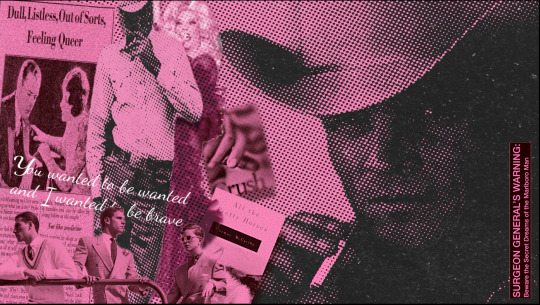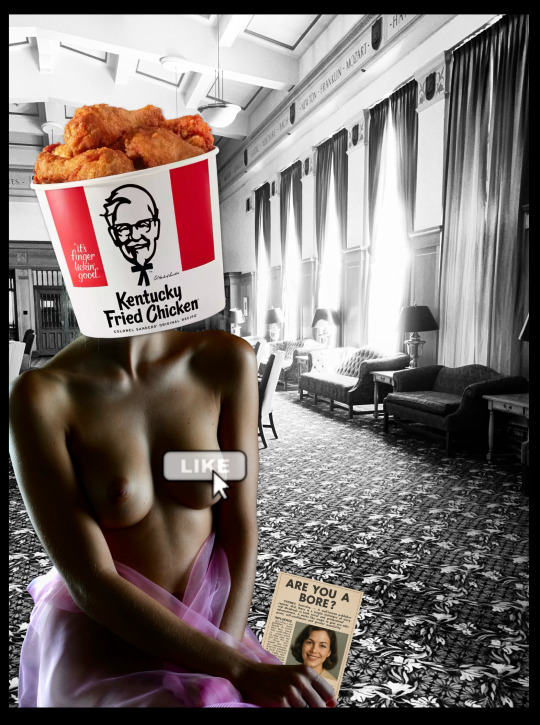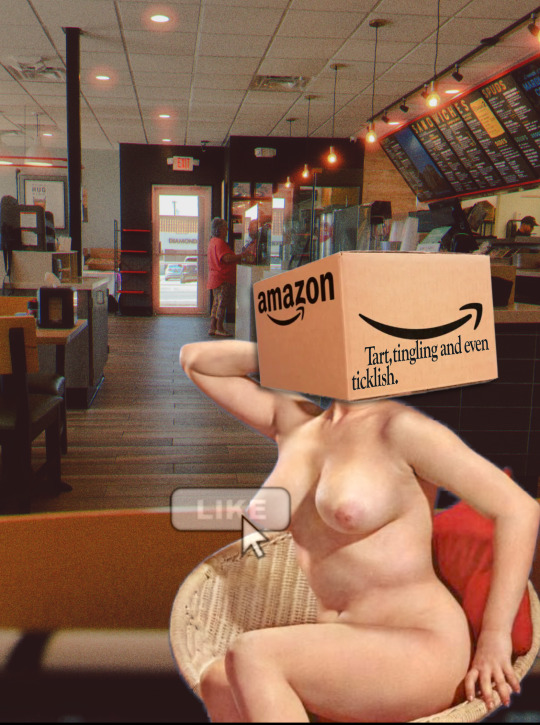Musings about my photos and photography. A lot of this will end up in a newsletter for my photo club. Unless noted, the images are all ©Tim Holt
Don't wanna be here? Send us removal request.
Text

More from my "Press Like and Subscribe Series" All images ©2025 Tim Holt Photography
In “Press Like and Subscribe,” the artist presents a biting, surreal collage series that interrogates the intersection of consumerism, objectification, and digital validation. Drawing from mid-century pin-up imagery and fusing it with contemporary brand symbols—fast food, surveillance tech, corporate logos, social media icons—these hybrid figures expose how female bodies are commodified, policed, and consumed across platforms and decades.
Each figure, stripped of identity and replaced with a literal product, becomes both a symbol and a satire: a camera watches, a burger smiles, a cardboard box sells itself. The recurring Facebook “like” icon serves as both a badge of approval and a censor bar, flattening individuality into quantifiable engagement. Settings range from hotel corridors to fast food joints to nostalgic domestic interiors, offering familiar yet uncanny backdrops where desire, boredom, and consumer culture converge.
At once humorous and unsettling, the series critiques how corporations manufacture identity, monetize intimacy, and condition our gaze—reminding viewers that in today’s culture, even attention is transactional, and bodies are brands.
0 notes
Text

Vintage pinup and some Filter action... ©Tim Holt Photography 2025
0 notes
Text

Using the Prequel App on a vintage ad. ©2025 Tim Holt Photography
0 notes
Text






Detail, Old Hand painted sign: Cloudcroft NM ©2025 Tim Holt Photography
3 notes
·
View notes
Text

"He never could figure out women" ©2025 Tim Holt Photography
0 notes
Text

For Pride month, I created this digital collage: "Beware the Secret Dreams of the Marlboro Man" ©2025 Tim Holt Photography
2 notes
·
View notes
Text






Works in Progress: From a series I am doing on Commercialization of the female form entitled: "Press Like and Subscribe" All images ©2025 Tim Holt Photography
“Press Like and Subscribe”
In “Press Like and Subscribe,” the TimHolt presents a biting, surreal collage series that interrogates the intersection of consumerism, objectification, and digital validation. Drawing from mid-century pin-up imagery and fusing it with contemporary brand symbols—fast food, surveillance tech, corporate logos, social media icons—these hybrid figures expose how female bodies are commodified, policed, and consumed across platforms and decades.
Each figure, stripped of identity and replaced with a literal product, becomes both a symbol and a satire: a camera watches, a burger smiles, a cardboard box sells itself. The recurring Facebook “like” icon serves as both a badge of approval and a censor bar, flattening individuality into quantifiable engagement. Settings range from hotel corridors to fast food joints to nostalgic domestic interiors, offering familiar yet uncanny backdrops where desire, boredom, and consumer culture converge.
At once humorous and unsettling, the series critiques how corporations manufacture identity, monetize intimacy, and condition our gaze—reminding viewers that in today’s culture, even attention is transactional, and bodies are brands.
0 notes
Text

"We make her paint her face and dance" Digital Collage ©2025 Tim Holt Photography Title: We make her paint her face and dance
Medium: Digital collage on archival print
Artist Statement
In We make her paint her face and dance, the artist constructs a layered meditation on the performance of femininity and the cultural machinery that scripts, distorts, and consumes it. At once seductive and unsettling, the work draws from mid-century pulp iconography, vintage erotica, and analog textures to critique how female identity has been shaped by external narratives—cinematic, mechanical, and commercial.
The central figure—posed, nude, and faceless—has her eyes obscured by a violent black smear, signaling both censorship and erasure. She is trapped beneath the ticking hands of a clock, a symbol of imposed timelines: youth, desirability, and obedience. Above her, a retro-styled woman looks distressed beneath the ironic proclamation: “This story was filmed on location… inside a woman’s soul!”—a hollow promise of empathy that only deepens the voyeuristic spectacle.
Set against a backdrop of vintage typewriter keys, the collage suggests that womanhood is a role authored by others, dictated through media, and replicated endlessly. The phrase that gives the work its title—“We make her paint her face and dance”—is printed faintly, almost resignedly, across the center. It serves as both indictment and elegy, implicating the viewer in a system that demands performance while silencing inner truth.
Through texture, nostalgia, and dissonance, the piece asks: when a woman’s image is crafted by the hands of others, what remains of the soul beneath?
0 notes
Text

Everyday is taco Tuesday
4 notes
·
View notes
Text
The Power of Photography: Capturing Moments, Inspiring Souls
Introduction: Dear congregation, today I want to take a moment to appreciate the wonders of photography and the art of printing images to hang on our walls. In this digital age where countless pictures are taken and stored in the cloud, we often forget the profound impact that a tangible photograph can have on our lives. Let us explore the virtues of photography as a hobby and the significance of printing and displaying these images as a testament to the beauty that surrounds us. I. The Art of Capturing Moments: Photography is a remarkable way to freeze time and capture fleeting moments that hold immeasurable significance. When we pick up a camera and frame the world through its lens, we become not just witnesses but storytellers. Every photograph has a story to tell, and it is through this visual medium that we can convey emotions, share experiences, and immortalize memories. Just as our lives are filled with cherished memories, so too can our walls be adorned with snapshots of those moments. Printed photographs, carefully selected and displayed, serve as a constant reminder of the joys, blessings, and triumphs we have experienced. They become portals to the past, evoking nostalgia, gratitude, and a sense of connection to the people, places, and events that have shaped our lives. II. Discovering Beauty in the Ordinary: In the pursuit of photography, we develop a unique perspective. We learn to appreciate the beauty hidden in the simplest things—a dewdrop on a flower petal, a ray of sunlight filtering through the trees, or the laughter shared between loved ones. Through the lens, we find new depths in everyday scenes and discover that the world around us is filled with awe-inspiring wonders waiting to be captured. When we choose to print and display our images, we transform these moments of beauty into something tangible. Hanging these photographs on our walls not only reminds us of the profound joy of discovery but also encourages us to pause, reflect, and find inspiration in the little things. They serve as windows to a world beyond our immediate surroundings, reminding us of the vastness and diversity of creation. III. Sharing Stories and Inspiring Souls: Photography is not merely a means of self-expression but a powerful way to share stories and touch the lives of others. When we capture a moment in time, we have the privilege of inviting others to witness the emotions, stories, and messages that lie within each photograph. Our images become bridges of understanding, empathy, and inspiration, transcending language and cultural barriers. By printing and displaying our photographs, we extend this invitation even further. As we hang these images on our walls, we create a gallery of personal experiences, a narrative that speaks volumes about who we are and what matters to us. Our guests, family, and friends are welcomed into our world and encouraged to share their own stories. This act of sharing fosters connection, fosters unity, and enriches our relationships. Conclusion: Dear friends, let us embrace photography as a hobby that not only brings us joy but also offers us a profound opportunity to capture the essence of life itself. As we take up our cameras and preserve moments in time, let us not forget the power of printing and displaying these images on our walls. Through this act, we invite others to join us in celebrating the beauty, the wonder, and the stories that define our lives. May our photographs become testaments to the joys we have experienced and inspire us to seek out the extraordinary in the ordinary. Let our walls become canvases of cherished memories and windows into the soul. May the blessings of art and photography be with you all. Amen.
0 notes
Text

As Bill Nye the Science Guy used to say, “Consider the following:”
Suppose in 1990 you took a photo of someone, your spouse maybe, say on the rim of the Grand Canyon. Your picture focused on the person, is a tight shot of their torso and face, with the Grand Canyon in the background. Nice shot. Good portrait.
Now, 33 years later, you revisit that image, sharpen it up, clean it, de-noise it, de-haze it, run it through a portrait enhancer to get rid of that nasty zit, put that picture into Photoshop and click on the Artificial Intelligence Tool “Generative Fill (aka Firefly).”
Generative AI tools like Firefly have the ability to expand a picture, to intelligently “fill in” parts that you want added to the picture, simply by typing in what you want it to make. This ability has been years in the making and uses vast storehouses of the billions of images that have been used to train it. As Adobe put it: “Generative Fill (or Firefly as they call it) automatically matches perspective, lighting and style of images to enable users achieve astounding results while reducing tedious tasks.”
That ability Adobe claims, comes from being trained on all those images that Adobe has in their stock image collection, photos in the public domain and photos that have Creative Commons copyrights, such as those in UnSpash.com.
You type in “Create a panoramic image of the Grand Canyon with this image of my spouse as the center.” Suddenly, your 33 year old up-close portrait of your spouse standing on the rim of the Grand Canyon is now a 180 degree panoramic image of the Grand Canyon and your spouse of just down there somewhere..oh there he is! He looks like one of the other “tourists” in the new picture.
That new image, that panorama of the Grand Canyon with your spouse now just a part of the larger picture instead of the focus of the created from all those OTHER images, raises a lot of questions, not chiefly among them, who created the photo? Was it you? Was it the software? Was it Adobe? Who should get credit? Literally millions of other photographers actually played a part in creating that image. Should they collectively get some credit?
Art has a long history of one person getting credit for works that were the original idea of one person but made by others. For instance, many of you recall Andy Warhol’s “Factory” where Warhol the artist would design the idea of something, but the other artists in the “Factory” actually create the final product. Jeff Koons does the same thing with his large scale art sculptures. He comes up with the initial idea, and others do the actual “creation.” But Koons and Warhol get the credit, and the money.
A similar debate happened way back when Photoshop first came out. Was it the photographer making the image or was it the software? I think we collectively decided Photoshop and all image editors were the modern day equivalent of the darkroom, so the conversation moved on. Generative AI has a subtle but I think significant difference: Editing filters, cropping tools and the like may alter the look and feel of a photo, but they, for the most part, don't alter the original content. Generative AI software fundamentally changes the original image by making it something removed from the original. That portrait of your spouse was not meant to be a panoramic image of the North Rim of the Grand Canyon.
Now it is.
Are you still the original photographer?
(Images are for illustrative purposes only. Generated by Dall-E)
0 notes
Text
The Paralysis of Choice
A few years ago, I wrote a blog post for one of my blogs about an experience my wife and I had while shopping. We went to the store with a list, and while I was getting the items on the list, my wife said she would go get some olives. I continued to shop and noticed her in the aisle with the olives as I passed by multiple times. I finished getting everything on the list and found my wife still in front of the olives, contemplating her choice. I asked her why she was taking so long, and she explained that there were so many options—green olives, black olives, Greek olives, stuffed olives, garlic olives, pitted or not pitted, sliced or whole, flavored or not flavored, with pimento or without, cream cheese stuffed, olive salad, large bottles, small bottles, cans—and she couldn't make up her mind. She mentioned that when she was young, there were only green and black olives, and now there were shelves full of choices, not to mention the olives at the olive bar in the front of the supermarket. This situation exemplified what I like to call the "Paralysis of Choice." When faced with too many options, it becomes difficult to make any decision at all. The Paralysis of Choice isn't limited to grocery shopping; it affects other aspects of our lives, including photography. We have always had choices like Nikon or Canon, original glass or off-brand. However, nowadays, the abundance of choices in photography is overwhelming. (An online article recently discussed the illogical naming conventions for various camera models. With names like Z5, Z6, Z6II, Z7, Z7II, Z8, or Z9, it's hard for consumers to understand the overwhelming differences.) This abundance of choices leads to indecision and the Paralysis of Choice. The same applies when you actually own a camera—the numerous settings can be overwhelming. It's tempting to just put the camera on "Auto" mode and rely on the technology to make decisions for us. However, this leaves us feeling guilty for not utilizing the control we paid for. Like buying a Ferrari and only going 25mph. So, how can we overcome the Paralysis of Choice? Well, as the saying goes, the journey of a thousand miles begins with a single step. Start small and take action. Choose one setting on your camera and experiment with it. Can't decide which camera to buy? Just go ahead and purchase the one you were considering instead of endlessly contemplating. Move away from "Auto" mode and explore manual settings like exposure and shutter speed. Try using a feature in your photo editor that you've never used before. Select an online printer like SAAL or ProPrints and get to know them well. Pick a paper for your own printer and stick with it instead of trying every paper available. Use that photo accessory you bought but never used before. Print one of your best photos and enter it in a competition or exhibition like the PEEPshow. Stop overthinking which photo is the best and simply submit them. You can overcome the Paralysis of Choice by taking action and freeing yourself from the state of indecision.
0 notes
